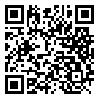Volume 21, Issue 63 (12-2021)
jgs 2021, 21(63): 99-117 |
Back to browse issues page
1- Associate Professor, University Of Mohaghegh Ardabili
2- Ph.D. student, University Of Mohaghegh Ardabili ,R.h.masoomabad@uma.ac.ir
3- Ph.D. student, University Of Mohaghegh Ardabili
2- Ph.D. student, University Of Mohaghegh Ardabili ,
3- Ph.D. student, University Of Mohaghegh Ardabili
Abstract: (7220 Views)
One of the most important and urgent issues of urban planning is the equitable distribution of facilities, services and accessibility of citizens at the urban level. Economic and commercial centers, including banks and financial institutions, are one of the most important economic sectors of cities and can be sustained. Social, economic, physical, and environmental impacts of neighborhoods. The purpose of this study was to investigate the extent of citizenschr('39') access to commercial land use in Ardebil neighborhoods. Therefore, the present study is applied in terms of purpose and descriptive-analytical in nature. The statistical population of the study is 44 localities of Ardabil city. Spatial statistics models, Hot Spot Analysis, and GIS software were used for data analysis. Finally, regression function in Idrisi Selva software was used to analyze the correlation between commercial user and population as well as to determine the relationship and correlation of this user with other service users. The results show that in Ardabil neighborhoods there is inequality in terms of overall business use. As a result, the neighborhoods have high commercial use weights and high concentrations of hot spots in optimum condition, including areas 3 and 5 from zone 2, zone 7 from zone 1 and zone 6 from zone 3. Also, commercial low weight blocks and low concentrations of hot spots, which include areas 8 and 11 from zone 2, area 11 from zone 3, are lower in urban sustainability. Finally, based on the results of the research, some suggestions have been made.
Article number: 6
Type of Study: Research |
Subject:
Geography and Urban Planning
| Rights and permissions | |
 |
This work is licensed under a Creative Commons Attribution-NonCommercial 4.0 International License. |





